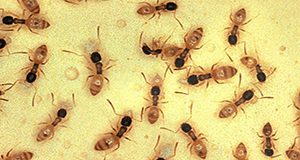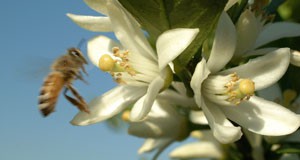Ants are one of a beekeeper’s most common pests, both in the apiary and in the honey house. Florida and the southeastern United States have a large and diverse ant fauna, with both native and exotic species. The vast majority of ant species have no impact on our bees or us. This 8-page fact sheet written by William H. Kern and published by the UF/IFAS Department of Entomology and Nematology describes the few pest species can cause serious problems and suggests ways to control the ants for healthier hives.
http://edis.ifas.ufl.edu/in1181
Tag: Bee Pests
Chalkbrood Recommendations
A pathogenic fungus called chalkbrood can turn infected larval honey bees into “mummies,” killing them and reducing their colony’s population and productivity. Florida’s subtropical climate may contribute to a greater incidence of the disease, which is common throughout the state. This 2-page fact sheet describing chalkbrood and listing some management strategies to control it was written by Malcolm T. Sanford, Cameron J. Jack, and Jamie Ellis, and published by the UF Department of Entomology and Nematology, December 2016.
http://edis.ifas.ufl.edu/aa138
How to Quantify Nosema Spores Infection Rate in a Honey Bee Colony
Nosema are single-celled fungal parasites that infect various animal hosts. One species, Nosema ceranae, has become the dominant microsporidian infection in western honey bee colonies. When honey bees ingest Nosema spores, many eventually starve to death because the spores replicate in the stomach and hijack the bee’s nutrition. The risk of Nosema infection can be particularly unsettling to beekeepers because colonies often do not show signs of infection until the colony is severely diminished.
This 5-page fact sheet written by Ashley N. Mortensen, Cameron J. Jack, Meghan McConnell, Liana Teigen, and Jamie Ellis and published by the Department of Entomology and Nematology explains how to diagnose and quantify Nosema infection in a honey bee colony.
http://edis.ifas.ufl.edu/in1123
Zombie Fly (suggested common name) Apocephalus borealis Brues (Insecta: Diptera: Phoridae)
 The zombie fly is primarily a parasitoid of bumble bees and wasps in North America. In 2012, Dr. John Hafernik and his colleagus at San Francisco State University discovered that Apocephalus borealis also parasitizes honey bees. Parasitized honey bees show zombie-like behavior by leaving their hives at night and are often attracted to nearby lights where they show disoriented behavior and die in a few hours. This 5-page fact sheet was written by Nicole A. Casuso, Ashley N. Mortensen, and James D. Ellis, and published by the UF Department of Entomology and Nematology, October 2014. (Photo: Jessica Andrieux, CC SA-BY 2.5)
The zombie fly is primarily a parasitoid of bumble bees and wasps in North America. In 2012, Dr. John Hafernik and his colleagus at San Francisco State University discovered that Apocephalus borealis also parasitizes honey bees. Parasitized honey bees show zombie-like behavior by leaving their hives at night and are often attracted to nearby lights where they show disoriented behavior and die in a few hours. This 5-page fact sheet was written by Nicole A. Casuso, Ashley N. Mortensen, and James D. Ellis, and published by the UF Department of Entomology and Nematology, October 2014. (Photo: Jessica Andrieux, CC SA-BY 2.5)
http://edis.ifas.ufl.edu/in1063
Wedge-Shaped Beetles (suggested common name) Ripiphorus spp. (Insecta: Coleoptera: Ripiphoridae)
 Ripiphoridae are a family of unusual parasitic beetles that are thought to be related to tumbling flower beetles and blister beetles. They parasitize bees and wasps, roaches, and wood-boring beetles, but specific hosts for many ripiphorid species are unknown. Their secretive life cycle makes an assessment of their economic and ecological impact very difficult. Additional research is necessary to determine the abundance and impact of Ripiphorus species. This 4-page fact sheet was written by David Owens, Ashley N. Mortensen, Jeanette Klopchin, William Kern, and Jamie D. Ellis, and published by the UF Department of Entomology and Nematology, December 2014.
Ripiphoridae are a family of unusual parasitic beetles that are thought to be related to tumbling flower beetles and blister beetles. They parasitize bees and wasps, roaches, and wood-boring beetles, but specific hosts for many ripiphorid species are unknown. Their secretive life cycle makes an assessment of their economic and ecological impact very difficult. Additional research is necessary to determine the abundance and impact of Ripiphorus species. This 4-page fact sheet was written by David Owens, Ashley N. Mortensen, Jeanette Klopchin, William Kern, and Jamie D. Ellis, and published by the UF Department of Entomology and Nematology, December 2014.
http://edis.ifas.ufl.edu/in1069
Tropilaelaps mite Tropilaelaps spp. Delfinado & Baker (Arachnida: Mesostigmata: Laelapidae)
 Honey bees throughout the world are exposed to numerous pests, parasites, and pathogens. One such parasite is Tropilaelaps spp. Delfinado & Baker, an ectoparasitic mite that feeds on the hemolymph of developing honey bees. Four species of Tropilaelaps have been identified and characterized. This 4-page fact sheet was written by Ashley N. Mortensen, Sarah Burleson, Gunasegaran Chelliah, Ken Johnson, Daniel R. Schmehl, and Jamie D. Ellis, and published by the UF Department of Entomology and Nematology, October 2014. (Photo credit: Pest and Diseases Image Library, Bugwood.org)
Honey bees throughout the world are exposed to numerous pests, parasites, and pathogens. One such parasite is Tropilaelaps spp. Delfinado & Baker, an ectoparasitic mite that feeds on the hemolymph of developing honey bees. Four species of Tropilaelaps have been identified and characterized. This 4-page fact sheet was written by Ashley N. Mortensen, Sarah Burleson, Gunasegaran Chelliah, Ken Johnson, Daniel R. Schmehl, and Jamie D. Ellis, and published by the UF Department of Entomology and Nematology, October 2014. (Photo credit: Pest and Diseases Image Library, Bugwood.org)
http://edis.ifas.ufl.edu/in1061
Florida Bears and Beekeeping (ENY105/AA133)
 The Florida black bear (Ursus americanus floridanus) is a minor predator of beehives in Florida with the potential to cause major destruction. Large-scale urban and agricultural development inexorably reduces prime bear habitat each year. This habitat also contains excellent bee forage, and so bears and bees will sometimes come in contact, thus resulting in bear predation. This 4-page fact sheet was written by Malcolm T. Sanford and James D. Ellis, and published by the UF Department of Entomology and Nematology, August 2012.
The Florida black bear (Ursus americanus floridanus) is a minor predator of beehives in Florida with the potential to cause major destruction. Large-scale urban and agricultural development inexorably reduces prime bear habitat each year. This habitat also contains excellent bee forage, and so bears and bees will sometimes come in contact, thus resulting in bear predation. This 4-page fact sheet was written by Malcolm T. Sanford and James D. Ellis, and published by the UF Department of Entomology and Nematology, August 2012.
http://edis.ifas.ufl.edu/aa133
Cape Honey Bee Apis mellifera capensis Escholtz (EENY513/IN916)
 Cape honey bees can produce both male and female offspring parthenogenetically. Unlike other African bee races, they are docile, but unlike all other races of honey bees, they are social parasites. Find out why South African beekeepers consider Cape bees a more serious threat than the varroa mite in this 4-page fact sheet was written by James D. Ellis, and published by the UF Department of Entomology and Nematology, December 2011.
Cape honey bees can produce both male and female offspring parthenogenetically. Unlike other African bee races, they are docile, but unlike all other races of honey bees, they are social parasites. Find out why South African beekeepers consider Cape bees a more serious threat than the varroa mite in this 4-page fact sheet was written by James D. Ellis, and published by the UF Department of Entomology and Nematology, December 2011.
http://edis.ifas.ufl.edu/in916
EENY474/IN854 Small Hive Beetle, Aethina tumida Murray (Insecta: Coleoptera: Nitidulidae)
EENY474, a 5-page illustrated fact sheet by James D. Ellis and Amanda Ellis, is part of the Featured Creatures collection. It describes this small beetle native to sub-Saharan Africa, which can cause considerable damage to colonies of European honey bees outside of its host range — distribution, description, life cycle, economic importance, and management. Includes references. Published by the UF Department of Entomology and Nematology, June 2010.
http://edis.ifas.ufl.edu/in854
EENY472/IN845 Bee louse, bee fly, braulid, Braula coeca Nitzsch (Insecta: Diptera: Braulidae)
EENY472, a 3-page illustrated fact sheet by James D. Ellis and C.M. Zettel Nalen, is part of the Featured Creatures collection. It describes this wingless fly that lives as a commensalist in western honeybee colonies — distribution, description, life cycle and behavior and management. Includes references. Published by the UF Department of Entomology and Nematology, April 2010.
http://edis.ifas.ufl.edu/in845


